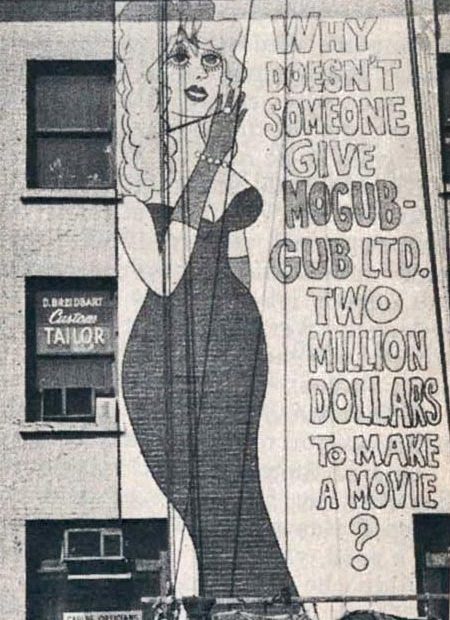This article was originally published on Dec. 16, 2020. I’m running it again today in part because I was gifted a reel of Fred Mogubgub’s work containing a (low-quality) short version of his c. 1973 animation for “American Pie,” the elegiac song Don McLean made famous as his coda to the ’60s. It seems appropriate to reprise both the song and film in response to the MAGA “revolution” taking shape during these first days of the Trump II imperium.
If in 1965 I had two million freshly minted, crisp green-backs, I would have had the honor of presenting this epochal artist with the dough to fund his film. But when Fred Mogubgub (1928–1989) was making revolutionary quick-cut, limited animation commercials and films (hard to find and all but forgotten today), I was a tyke with $10 in the bank. I was only 15 when I saw this painted sign for the first time and wondered “what is a Mogubgub?” I met him years after he created this billboard. He was then producing quirky opening and closing sequences for TV shows like Tom Chapin’s “Make A Wish”.
When I met Fred in 1970, making his own brand of psychedelic-surrealist comics at The East Village Other, the name Mogubgub sounded to me like a melodic nonsense word or a rare insect rather than an avant garde artist. So what was he doing during the 1960s? Fred Mogubgub was a filmmaker, animator, painter and cartoonist who partnered with Pablo Ferro in two animation studios—Ferro Mogubgub Lew, then Ferro Mogubgub Schwartz— before starting his own studio. As noted on Cartoon Brew: Mogubgub “was an important part of New York’s indie animation scene in the 1960s and 1970s.” His films are exemplary examples of pop art in motion. He was also creator of The Pop Show from the late 1960s, a quick-cut parade of pop icons, featuring “a pre-Playboy, pre-N. O. W. Gloria Steinem” slugging down odd-ball hi-balls.
Mogubgub’s TV work was known for its staccato jump-cuts—an assemblage of cartoons and photographs that instantly flashed across the screen. He made work for Ford, Coca-Cola and Life Savers. He admitted that his subject matter derived from “American objects which stick out from the clichés you get drilled into you in school.” He was given the slogan, “Have you ever heard anyone say ‘no’ to a Life Saver?” by the Beech-Nut people and made a pop commercial. A marketing survey reported that the public recalled this commercial with its raw graphic effects more often than conventional ads.
However, he wanted out of the commercial business. He had film and painting in his sights. Mogubgub’s best known film, Enter Hamlet, was commissioned by The School of Visual Arts: It was Maurice Evans’ elegaic reading of Hamlet’s Soliloquey is poised against pop graphics. Each word is represented by a drawing, each scene cut to the word.
He was naturally drawn to and most welcome at the East Village Other, in a loft above the Fillmore East on Second Avenue and 6th Street. Routinely, he would arrive late on paste-up night usually stoned, proceed to a lamp-lit corner where he’d draw his stream-of-consciousness work. Like the cover below, he liked to print in two split fountain inks often using hard-to-read yellow; he’d finish a few minutes before the art was sent off to Druss printers in Long Island. There were no proofs. Serendipity was the goal.
One night at a paste-up session, he invited the staff to help him throw all his expensive camera equipment into the Hudson River early the next morning. He said he was forever finished with making film (although in 1979 he worked on an incredible sequence in R.O. Blechman’s epic “A Soldier’s Tale”). I oversleep and never knew for certain whether he did it or not. I do know that he was working on a two-story high painting for which he had to cut a hole in the ceiling of his loft. Whether the painting (created in square sections) was ever completed, I do not know.
What I do know, is that he deserves a museum retrospective if his artwork did not meet the same reputed fate as did his cameras. Mogubgub died in 1989 at 61.
If you prefer a slightly higher-quality version, go here.
The post The Daily Heller: Why Didn’t Someone Give Fred Mogubgub Two Million Dollars? A Reprise appeared first on PRINT Magazine.
